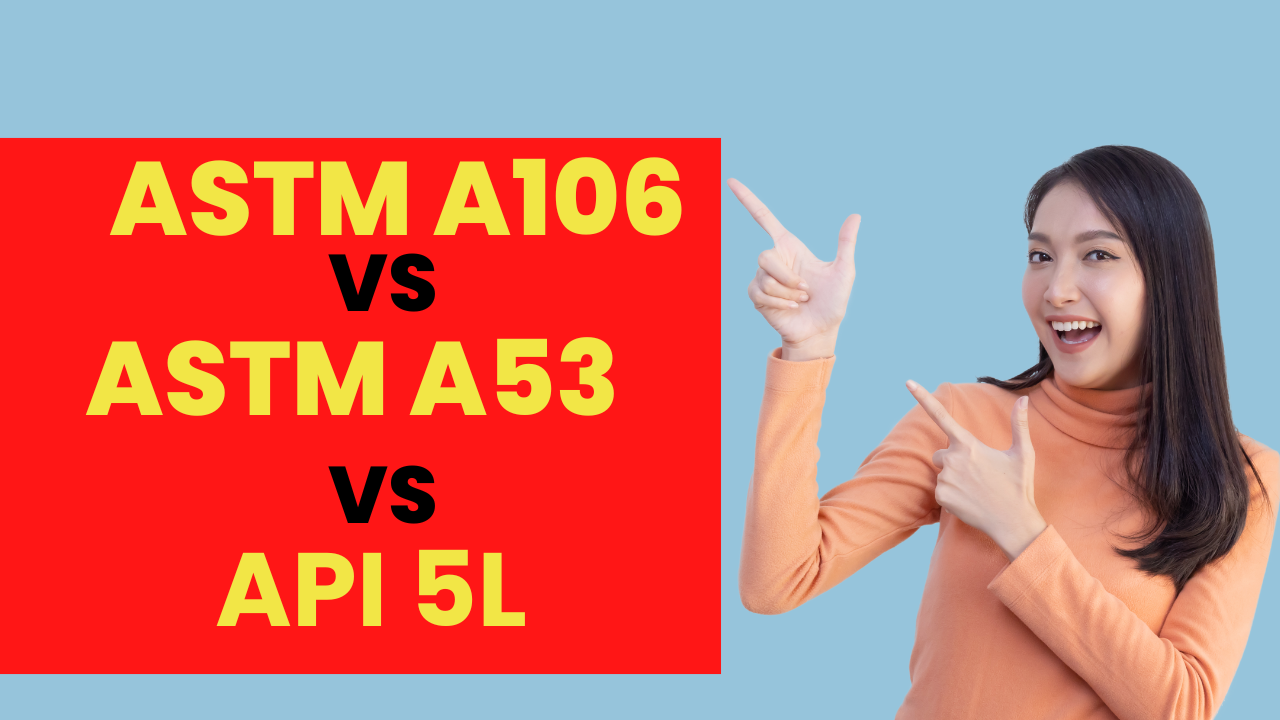1. Introduction
Carbon steel pipes are essential components in various industries, providing the means for transporting fluids and gases. Three widely used standards for carbon steel pipes are ASTM A106, ASTM A53, and API 5L, each designed for specific applications. Understanding the differences between these standards is crucial for selecting the right pipe for your project.
Table of Contents
Do not miss the detailed course 7 Modules of Piping Codes & Standards
Enrollment link
Check out the Similar Articles on ASTM Standards
The Role of Carbon Steel Pipes
Carbon steel pipes are known for their durability and versatility, making them essential for applications ranging from plumbing to structural support in buildings.
ASTM and API Standards for Quality Assurance
ASTM and API standards ensure the quality, consistency, and reliability of carbon steel pipes, making them the preferred choice in various industries.
2. ASTM A106: Seamless Carbon Steel Pipe
ASTM A106 is a standard specification for seamless carbon steel pipes used for high-temperature services. It is suitable for applications that involve bending, flanging, and similar forming operations.
ASTM A106 Grades
- A106 Grade A: Suitable for low-temperature service and ideal for flanging or similar forming operations.
- A106 Grade B: The most commonly used grade with broad applications in high-temperature services.
- A106 Grade C: For applications requiring enhanced tensile strength.
Mechanical Properties of ASTM A106
- Tensile Strength: Minimum 60,000 psi (415 MPa).
- Yield Strength: Minimum 35,000 psi (240 MPa).
- Elongation: 30% minimum.
- Hardness: Not specified.
Do not miss the detailed course 7 Modules of Piping Codes & Standards
Enrollment link
3. ASTM A53: Welded and Seamless Carbon Steel Pipe
ASTM A53 is a standard specification for both welded and seamless carbon steel pipes. It is suitable for general applications, including plumbing and low-pressure steam, water, and air lines.
ASTM A53 Grades
- A53 Type F: Furnace-welded pipe with a continuous weld for general use.
- A53 Type E: Electric-resistance-welded pipe with a longitudinal weld for general use.
- A53 Type S: Seamless pipe with a seamless finish, suitable for high-temperature service.
Mechanical Properties of ASTM A53
- Tensile Strength: Minimum 60,000 psi (415 MPa).
- Yield Strength: Minimum 35,000 psi (240 MPa).
- Elongation: 30% minimum.
- Hardness: Not specified.
4. API 5L: Line Pipe for Transportation of Petroleum and Natural Gas
API 5L is a widely used standard for carbon steel pipes specifically designed for the transportation of petroleum and natural gas. It encompasses various grades, including API 5L Grade B, X42, X52, X65, and more.
API 5L Grades
- API 5L Grade B: The most commonly used grade for general applications.
- API 5L X42: Suitable for pipelines with moderate pressure and temperature.
- API 5L X52: Designed for pipelines with high-pressure and high-temperature requirements.
- API 5L X65: Ideal for pipelines in harsh environmental conditions.
Mechanical Properties of API 5L
- Tensile Strength: Varies with different grades, e.g., minimum 60,000 psi (415 MPa) for Grade B.
- Yield Strength: Varies with different grades, e.g., minimum 35,000 psi (240 MPa) for Grade B.
- Elongation: Minimum 23% for most grades.
- Hardness: Not specified.
5. Differences Between ASTM A106, ASTM A53, and API 5L
While these three standards deal with carbon steel pipes, they have distinct differences that affect their suitability for specific applications.
Manufacturing Process
- ASTM A106: Seamless pipes manufactured using a hot or cold-drawn process, resulting in a uniform and seamless finish.
- ASTM A53: Welded pipes can be furnace-welded (Type F), electric-resistance-welded (Type E), or seamless (Type S).
- API 5L: Generally, seamless pipes are preferred, but it also allows for electric-resistance-welded (ERW) and submerged arc-welded (SAW) pipes, primarily for larger diameters.
Application Focus
- ASTM A106: Designed for high-temperature applications and bending/forming operations, such as refineries and power plants.
- ASTM A53: Suited for general applications, including plumbing and low-pressure systems.
- API 5L: Specifically designed for the transportation of petroleum and natural gas in pipelines.
Pressure and Temperature Ratings
- ASTM A106: Suitable for high-temperature, high-pressure services.
- ASTM A53: Designed for general, low-pressure applications with lower temperature requirements.
- API 5L: Varies by grade but generally suitable for high-pressure and high-temperature applications in the oil and gas industry.
Do not miss the detailed course 7 Modules of Piping Codes & Standards
Enrollment link
6. Comparison Tables (Differences/Similarities)
Let’s delve into detailed comparison tables for chemical properties, mechanical properties, manufacturing processes, quality control & testing, and supplementary testing requirements.
6.1. Comparison (Differences/Similarities) for Chemical Properties
| Property | ASTM A106 | ASTM A53 | API 5L |
|---|---|---|---|
| Carbon (C) | Varies by grade | Varies by grade | Varies by grade |
| Manganese (Mn) | Varies by grade | Varies by grade | Varies by grade |
| Phosphorus (P) | Maximum 0.035% | Maximum 0.050% | Maximum 0.030% |
| Sulfur (S) | Maximum 0.035% | Maximum 0.050% | Maximum 0.030% |
| Silicon (Si) | Minimum 0.10% for Grade C | Varies by grade | Varies by grade |
| Chromium (Cr) | Varies by grade | Varies by grade | Varies by grade |
| Molybdenum (Mo) | Varies by grade | Varies by grade | Varies by grade |
| Nickel (Ni) | Varies by grade | Varies by grade | Varies by grade |
6.2. Comparison (Differences/Similarities) for Mechanical Properties
| Property | ASTM A106 | ASTM A53 | API 5L |
|---|---|---|---|
| Tensile Strength | Minimum 60,000 psi | Minimum 60,000 psi | Varies by grade |
| Yield Strength | Minimum 35,000 psi | Minimum 35,000 psi | Varies by grade |
| Elongation | Minimum 30% | Minimum 30% | Minimum 23% |
| Hardness | Not specified | Not specified | Not specified |
6.3. Comparison (Differences/Similarities) for Manufacturing Process
| Property | ASTM A106 | ASTM A53 | API 5L |
|---|---|---|---|
| Seamless | Yes | Depends on type (Type S) | Yes (Preferred) |
| Electric-Resistance-Welded (ERW) | No | Yes (Type E) | Yes (Some Grades, e.g., Grade B) |
| Furnace-Welded | No | Yes (Type F) | No |
| Submerged Arc-Welded (SAW) | No | No | Yes (Some Grades) |
6.4. Comparison (Differences/Similarities) for Quality Control & Testing
| Property | ASTM A106 | ASTM A53 | API 5L |
|---|---|---|---|
| Chemical Analysis | Rigorous chemical analysis to verify the elemental composition. | Rigorous chemical analysis to verify the elemental composition. | Rigorous chemical analysis to verify the elemental composition. |
| Mechanical Testing | Mechanical testing, including tensile and yield strength tests. | Mechanical testing, including tensile and yield strength tests. | Mechanical testing, including tensile and yield strength tests. |
| Non-Destructive Testing (NDT) | Non-destructive testing methods like ultrasonic testing (UT) and radiographic testing (RT). | Non-destructive testing methods like ultrasonic testing (UT) and radiographic testing (RT). | Non-destructive testing methods like ultrasonic testing (UT) and radiographic testing (RT). |
| Visual Inspection | Visual inspection for surface imperfections, weld defects, and dimensional conformity. | Visual inspection for surface imperfections, weld defects, and dimensional conformity. | Visual inspection for surface imperfections, weld defects, and dimensional conformity. |
6.5. Comparison (Differences/Similarities) for Supplementary Testing Requirements
| Supplementary Testing | ASTM A106 | ASTM A53 | API 5L |
|---|---|---|---|
| Hydrostatic Testing | Commonly performed to check for leaks or weaknesses by subjecting the pipes to high-pressure water. | Commonly performed to check for leaks or weaknesses by subjecting the pipes to high-pressure water. | Commonly performed to check for leaks or weaknesses by subjecting the pipes to high-pressure water. |
| Non-Destructive Testing (NDT) | Common supplementary tests include ultrasonic testing (UT) and radiographic testing (RT) to detect surface and internal defects. | Common supplementary tests include ultrasonic testing (UT) and radiographic testing (RT) to detect surface and internal defects. | Common supplementary tests include ultrasonic testing (UT) and radiographic testing (RT) to detect surface and internal defects. |
| Mechanical Testing | Mechanical testing may be required to assess specific properties based on the grade and application. | Mechanical testing may be required to assess specific properties based on the grade and application. | Mechanical testing may be required to assess specific properties based on the grade and application. |
| Impact Testing | Impact testing may be required to evaluate the material’s resistance to low-temperature brittleness, depending on the grade and application. | Impact testing may be required to evaluate the material’s resistance to low-temperature brittleness, depending on the grade and application. | Impact testing may be required to evaluate the material’s resistance to low-temperature brittleness, depending on the grade and application. |
| Other Supplementary Tests | Additional tests may be required based on specific project or application requirements. | Additional tests may be required based on specific project or application requirements. | Additional tests may be required based on specific project or application requirements. |
Do not miss the detailed course 7 Modules of Piping Codes & Standards
Enrollment link
7. Conclusion
In summary, ASTM A106, ASTM A53, and API 5L are crucial standards that define the quality and suitability of carbon steel pipes for various applications. While ASTM A106 is ideal for high-temperature services and bending/forming operations, ASTM A53 is more versatile and suitable for general plumbing and low-pressure systems. API 5L, on the other hand, is specifically designed for the transportation of petroleum and natural gas in pipelines. Understanding these differences and the detailed comparison tables is vital for selecting the right carbon steel pipe to meet your project’s specific needs.
8. FAQs
1. What is ASTM A106? ASTM A106 is a standard specification for seamless carbon steel pipes designed for high-temperature services and bending/forming operations.
2. What is ASTM A53? ASTM A53 is a standard specification for both welded and seamless carbon steel pipes suitable for general applications, including plumbing and low-pressure systems.
3. What is API 5L? API 5L is a standard specifically designed for carbon steel pipes used in the transportation of petroleum and natural gas in pipelines.
4. What are the mechanical properties of these standards? All three standards specify minimum tensile strength, yield strength, elongation, and hardness requirements to ensure the pipes’ mechanical integrity. The specific values vary depending on the grade and type of pipe.
5. What are the differences in manufacturing processes? ASTM A106 primarily deals with seamless pipes, while ASTM A53 allows for both seamless and welded pipes. API 5L generally prefers seamless pipes but also permits electric-resistance-welded (ERW) and submerged arc-welded (SAW) pipes for larger diameters.
Recommended courses (Published on EPCLand):
- Basics of Piping Engineering
- Piping Layout Engineering
- Piping Material Engineering
- Piping Stress Analysis
- Complete Course on Piping Engineering
- Material Requisitions
- Piping Material Specifications
- Valve Material Specifications
Related Video
Attempt Quiz
Question 1:
What do ASTM A106, ASTM A53, and API 5L standards primarily relate to?
Explanation: ASTM A106, ASTM A53, and API 5L standards primarily relate to the specifications and requirements for steel pipe used in fluid transportation, such as oil and gas pipelines.
Question 2:
What is the primary difference between ASTM A106 and ASTM A53?
Explanation: The primary difference between ASTM A106 and ASTM A53 is that ASTM A106 is for seamless pipes used in high-temperature service, while ASTM A53 covers both welded and seamless pipes for general use.
Question 3:
Which standard is commonly used for oil and gas pipelines?
Explanation: API 5L is commonly used for oil and gas pipelines as it specifies requirements for the manufacture of two product specification levels (PSL 1 and PSL 2) of seamless and welded steel pipes for use in pipeline transportation systems.
Question 4:
Which standard specifies requirements for pipe manufacturing processes such as seamless or electric resistance welding?
Explanation: Among the given options, API 5L specifies requirements for various manufacturing processes of steel pipes, including seamless and electric resistance welding methods.
Question 5:
Which standard provides guidelines for designing and constructing pressure piping systems?
Explanation: ASME B31.3 provides guidelines for designing, constructing, and inspecting pressure piping systems, including specifications for materials and joining methods.



